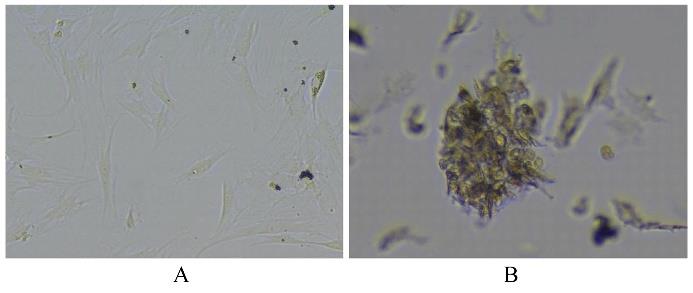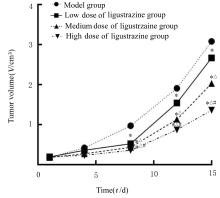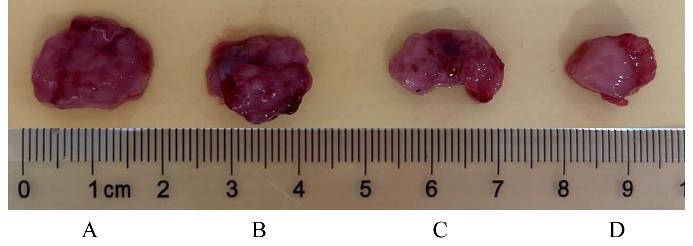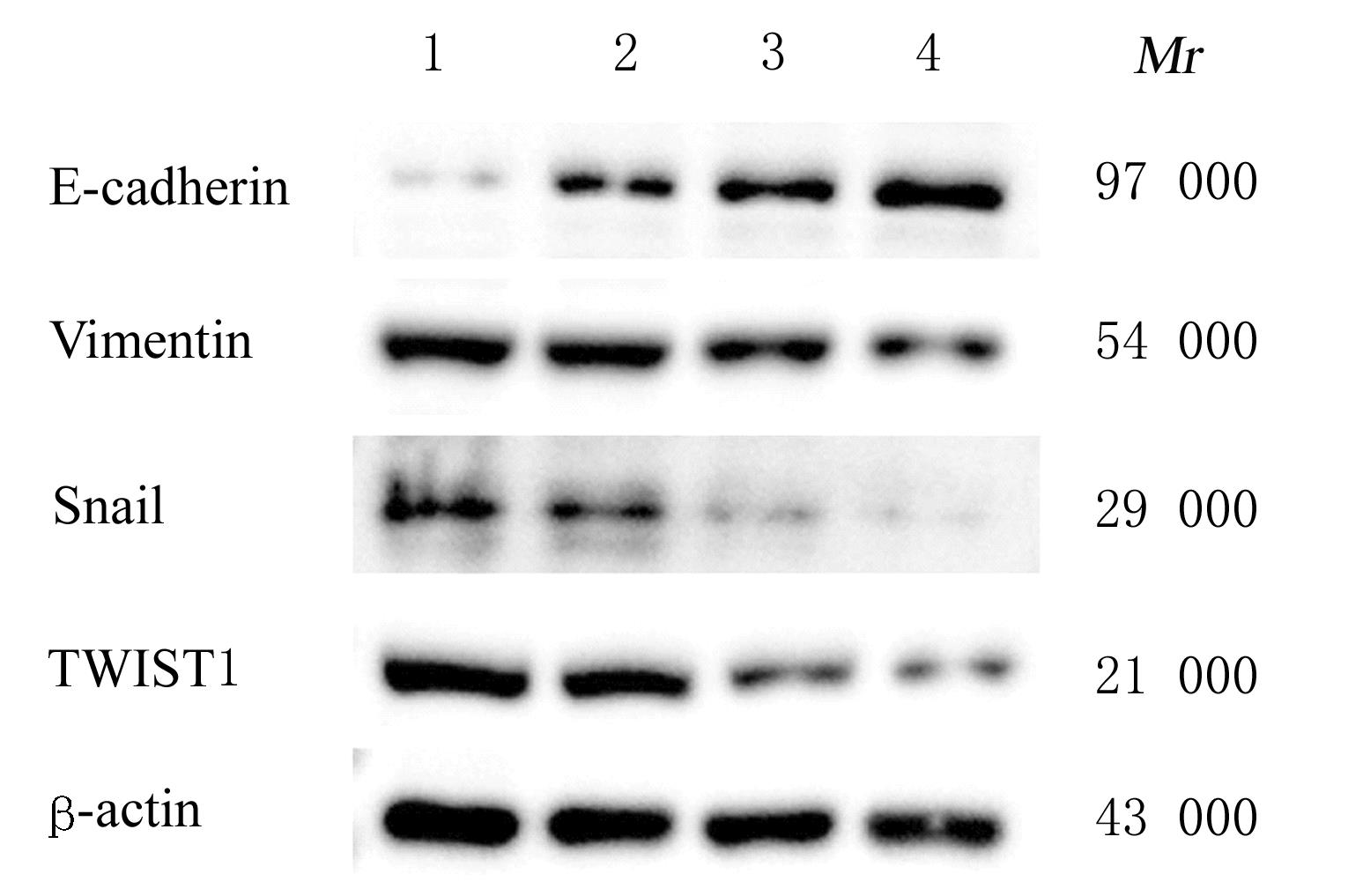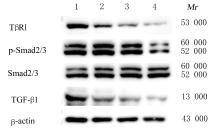Journal of Jilin University(Medicine Edition) ›› 2023, Vol. 49 ›› Issue (6): 1437-1444.doi: 10.13481/j.1671-587X.20230605
• Research in basic medicine • Previous Articles Next Articles
Influence of ligustrazine on growth of glioma stem cells subcutaneous xenografts in nude mice, TGF-β signaling pathway, and epithelial-mesenchymal transiton
Tao HE( ),Zhenjiang LI,Bingqian DING
),Zhenjiang LI,Bingqian DING
- Huaihe Hospital of Henan University Neurosurgery Department,Kaifeng 475000,China
-
Received:2022-10-21Online:2023-11-28Published:2023-12-22 -
Contact:Tao HE E-mail:hetaoky@163.com
CLC Number:
- R285.5
Cite this article
Tao HE,Zhenjiang LI,Bingqian DING. Influence of ligustrazine on growth of glioma stem cells subcutaneous xenografts in nude mice, TGF-β signaling pathway, and epithelial-mesenchymal transiton[J].Journal of Jilin University(Medicine Edition), 2023, 49(6): 1437-1444.
share this article
Tab.3
Expression levels of EMT-related proteins in transplanted tumor tissue of nude mice in various groups"
| Group | E-cadherin | Vimentin | Snail | TWIST1 |
|---|---|---|---|---|
| Model | 0.28±0.02 | 0.74±0.04 | 0.59±0.05 | 0.61±0.03 |
| Ligustrazine | ||||
| Low dose | 0.34±0.02* | 0.48±0.02* | 0.43±0.04* | 0.53±0.03* |
| Medium dose | 0.78±0.03*△ | 0.27±0.02*△ | 0.21±0.02*△ | 0.24±0.02*△ |
| High dose | 0.91±0.06*△# | 0.17±0.01*△# | 0.15±0.02*△# | 0.11±0.01*△# |
Tab.4
Expression levels of TGF-β signaling pathway proteins in transplanted tumor tissue of nude mice in various groups"
| Group | TβRⅠ | p-Smad2/3 | Smad2/3 | TGF-β1 |
|---|---|---|---|---|
| Model | 0.58±0.03 | 0.72±0.05 | 0.86±0.04 | 0.73±0.04 |
| Ligustrazine | ||||
| Low dose | 0.41±0.03* | 0.52±0.03* | 0.88±0.04 | 0.62±0.03* |
| Medium dose | 0.23±0.02*△ | 0.35±0.03*△ | 0.88±0.03 | 0.38±0.02*△ |
| High dose | 0.16±0.01*△# | 0.26±0.02*△# | 0.87±0.04 | 0.13±0.02*△# |
| 1 | CHOW K H, PARK H J, GEORGE J, et al. S100A4 is a biomarker and regulator of glioma stem cells that is critical for mesenchymal transition in glioblastoma[J]. Cancer Res, 2017, 77(19): 5360-5373. |
| 2 | ZHAO W J, FAN Y P, OU G Y, et al. LASS2 impairs proliferation of glioma stem cells and migration and invasion of glioma cells mainly via inhibition of EMT and apoptosis promotion[J]. J Cancer, 2022, 13(7): 2281-2292. |
| 3 | YAN J, ZHAO Q N, WANG J, et al. FGL2-wired macrophages secrete CXCL7 to regulate the stem-like functionality of glioma cells[J]. Cancer Lett, 2021, 506: 83-94. |
| 4 | MARÍN-RAMOS N I, THEIN T Z, CHO H Y, et al. NEO212 inhibits migration and invasion of glioma stem cells[J]. Mol Cancer Ther, 2018, 17(3): 625-637. |
| 5 | SONG Y, CHEN Y, LI Y Q, et al. Resveratrol suppresses epithelial-mesenchymal transition in GBM by regulating smad-dependent signaling[J]. Biomed Res Int, 2019, 2019: 1321973. |
| 6 | 吴腾飞, 董婉维, 王熙悦, 等. 川芎嗪通过调控PI3K/Akt信号通路抑制三阴乳腺癌的增殖侵袭和EMT[J]. 解剖科学进展, 2020, 26(3): 295-298. |
| 7 | 周宋汇, 汪瑞辰, 肖 红. 川芎嗪逆转脂肪细胞介导的卵巢癌奥沙利铂耐药的作用及机制研究[J]. 中国医院药学杂志, 2020, 40(6): 644-648. |
| 8 | 曹艳华, 薛 霞, 李 娟, 等. 川芎嗪对肾透明细胞癌增殖和侵袭作用及其机制的研究[J]. 中国免疫学杂志, 2019, 35(20): 2477-2482. |
| 9 | WANG J G, CAZZATO E, LADEWIG E, et al. Clonal evolution of glioblastoma under therapy[J]. Nat Genet, 2016, 48(7): 768-776. |
| 10 | JIA M B, WANG Y, GUO Y X, et al. Nitidine chloride suppresses epithelial-mesenchymal transition and stem cell-like properties in glioblastoma by regulating JAK2/STAT3 signaling[J]. Cancer Med, 2021, 10(9): 3113-3128. |
| 11 | CHESNELONG C, RESTALL I, WEISS S. Isolation and culture of glioblastoma brain tumor stem cells[J]. Methods Mol Biol, 2019, 1869: 11-21. |
| 12 | WANG Z Y, ZHANG H, XU S C, et al. The adaptive transition of glioblastoma stem cells and its implications on treatments[J]. Signal Transduct Target Ther, 2021, 6(1): 124. |
| 13 | XIE H J, ZHAO J, ZHUO-MA D Z, et al. Inhibiting tumour metastasis by DQA modified paclitaxel plus ligustrazine micelles in treatment of non-small-cell lung cancer[J].Artif Cells Nanomed Biotechnol,2019,47(1): 3465-3477. |
| 14 | ZOU Y, ZHAO D, YAN C, et al. Novel ligustrazine-based analogs of piperlongumine potently suppress proliferation and metastasis of colorectal cancer cells in vitro and in vivo [J]. J Med Chem, 2018, 61(5): 1821-1832. |
| 15 | DONG Y H, YANG Y J, WEI Y L, et al. Ligustrazine eases lung cancer by regulating PTEN and Wnt/ β-catenin pathway[J]. Transl Cancer Res, 2020, 9(3): 1742-1751. |
| 16 | CHEN X C, YANG X D, MU J F, et al. Ligustrazine inhibits the viability and motility of colon cancer cells[J]. Transl Cancer Res, 2020, 9(5): 3203-3213. |
| 17 | MA Y S, WU Z J, BAI R Z, et al. DRR1 promotes glioblastoma cell invasion and epithelial-mesenchymal transition via regulating AKT activation[J]. Cancer Lett, 2018, 423: 86-94. |
| 18 | TANIA M, KHAN M A, FU J J. Epithelial to mesenchymal transition inducing transcription factors and metastatic cancer[J]. Tumour Biol, 2014, 35(8): 7335-7342. |
| 19 | CAJA L, TZAVLAKI K, DADRAS M S, et al. Snail regulates BMP and TGFβ pathways to control the differentiation status of glioma-initiating cells[J]. Oncogene, 2018, 37(19): 2515-2531. |
| 20 | CILIBRASI C, RIVA G, ROMANO G, et al. Resveratrol impairs glioma stem cells proliferation and motility by modulating the Wnt signaling pathway[J]. PLoS One, 2017, 12(1): e0169854. |
| 21 | SYED V. TGF-β signaling in cancer[J]. J Cell Biochem, 2016, 117(6): 1279-1287. |
| 22 | LI T T, HUANG H P, SHI G Y, et al.TGF-β1-SOX9 axis-inducible COL10A1 promotes invasion and metastasis in gastric cancer via epithelial-to-mesenchymal transition[J].Cell Death Dis,2018,9(9): 849. |
| 23 | CHEN Z T, CHEN Y H, LI Y, et al. Prrx1 promotes stemness and angiogenesis via activating TGF-β/smad pathway and upregulating proangiogenic factors in glioma[J]. Cell Death Dis, 2021, 12(6): 615. |
| [1] | Hui YE,Zhe SUN,Liting ZHOU,Wen QI,Lin YE. Bioinformatics analysis on differentially expressed genes in lung adenocarcinoma based on GEO and TCGA Databases [J]. Journal of Jilin University(Medicine Edition), 2023, 49(6): 1491-1503. |
| [2] | Manying OU,Chunxia HU,Yueping LI. Effect of expression of microtubule inhibitory assembly protein 1 in placenta tissue of pre-eclampsia patients on trophoblast cells and its mechanism [J]. Journal of Jilin University(Medicine Edition), 2023, 49(6): 1519-1527. |
| [3] | Dandan WANG,Ning ZHOU,Dongqin LIU,Jie ZHAO,Chao LIANG,Juanjuan DAI,Yan WU. Effect of miR-491-5p over-expression on proliferation and migration of human nasopharyngeal carcinoma HONE-1 cells [J]. Journal of Jilin University(Medicine Edition), 2023, 49(5): 1134-1139. |
| [4] | Meng QYU,Yuzhu JIANG,Rui HUANG,Zhenzhuo MA,Jichen XIA,Yuan ZHANG,Zhiheng DONG. Protective effect of ginsenoside Rh2 on kidney injury in rats with diabetic kidney lesions and its mechanism [J]. Journal of Jilin University(Medicine Edition), 2023, 49(5): 1168-1173. |
| [5] | Gaofeng ZHOU,Jing XIAO,Jia ZHOU,Junxiu LIU,Guangfu LYU,Yuchen WANG,He LIN,Xiaowei HUANG. Protective effect of Velvet antler polypeptide pretreatment on myocardial H9c2 cell injury induced by TBHP through regulating TGF-β/Smad signaling pathway with miR-133a [J]. Journal of Jilin University(Medicine Edition), 2023, 49(2): 369-376. |
| [6] | Rui LI,Xiaodong TAN,Yaoyuan HU. Inhibitory effect of pachylic acid on migration, invasion, and epithelial-mesenchymal transition of human pancreatic cancer PANC-1 cells [J]. Journal of Jilin University(Medicine Edition), 2023, 49(2): 315-323. |
| [7] | Junxiong ZHAO,Qian WU,Liangui NIE,Shengquan LIU,Zhentao JIANG,Jian CHEN,Ting XIAO,Jun YANG. Ameliorative effect of SO2 on myocardial fibrosis in type 2 diabetes mellitus rats and its mechanism [J]. Journal of Jilin University(Medicine Edition), 2023, 49(1): 8-14. |
| [8] | Meng QYU,Hong ZHENG,Yan LI,Boxue CHEN,Yuzhu JIANG,Shenggao WANG,Chunyan YU,Zhiheng DONG. Inhibitory effect of fermented red ginseng total saponins high glucose-induced renal tubular cell epithelial-mesenchymal transition and its mechanism [J]. Journal of Jilin University(Medicine Edition), 2022, 48(5): 1182-1189. |
| [9] | Juan CAO,Weibo LI,Xiu GUO,Bo LI,Chunling DONG. Effects of targeted silencing of heat shock protein 27 on invasion and migration of oral squamous cell carcinoma CAL27 cells and their mechanisms [J]. Journal of Jilin University(Medicine Edition), 2021, 47(4): 971-977. |
| [10] | Mingbo JIA,Ying SUN,Ying WANG,Yanke SONG,Liyan ZHAO. Inhibitory effect of nitidine chloride on epithelial-mesenchymal transition of glioma cells through JAK2/STAT3 signaling pathway [J]. Journal of Jilin University(Medicine Edition), 2021, 47(1): 73-81. |
| [11] | Xiangteng LIU,Guilan WANG,Jiayan RONG,Juan HUANG,Jiabiao LIN,Dongming HUANG,Bingjie WANG. Analysis on correlations between serum level of TGF-β1 and severity of bronchiolitis and pulmonary function indexes [J]. Journal of Jilin University(Medicine Edition), 2020, 46(6): 1293-1297. |
| [12] | WEI Xujing, LI Lin, ZHANG Hongzhen, WANG Jing, XU Jing. Effects of LncRNA CCAT1 on proliferation,invasion and migration of endometrial cancer cells through TGF-β1/smad signaling pathway [J]. Journal of Jilin University(Medicine Edition), 2020, 46(05): 1016-1022. |
| [13] | ZHOU Ning, WU Rui, MA Zhenkai, CHEN Weiwei, LI Xuelin, GONG Kaikai, YANG Lijuan, DAI Juanjuan, WU Yan. Effects of down-regulation of ADAR1 expression on proliferation, migration and epithelial-mesenchymal transition of human lung cancer cells [J]. Journal of Jilin University(Medicine Edition), 2020, 46(04): 669-674. |
| [14] | DONG Zhuo, LI Jiale, CHEN Xiaoyi, WANG Rui, YI Junxuan, WEI Xinfeng, JIN Shunzi. Effect of NRP1 gene knockout on process of radiation-induced pulmonary fibrosis and its mechanism [J]. Journal of Jilin University(Medicine Edition), 2020, 46(01): 26-34. |
| [15] | YANG Zhiyuan, WEN Naiyan, LIN Yang, LIANG Hang, WANG Qian, HU Xindan, ZHANG Ling, REN Hui, GUO Baofeng. Inhibitory effect of SF2523 on proliferation of human glioma stem cells TS576 and its mechanism [J]. Journal of Jilin University(Medicine Edition), 2019, 45(06): 1281-1287. |
|

